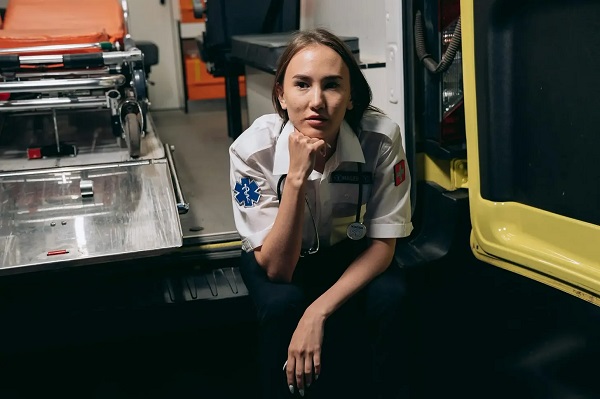COVID-19
Downtown Ottawa resident surprised when he meets the protestors he was warned about

From maybury.ca
A night with the untouchables
I live in downtown Ottawa, right in the middle of the trucker convoy protest. They are literally camped out below my bedroom window. My new neighbours moved in on Friday and they seem determined to stay. I have read a lot about what my new neighbours are supposedly like, mostly from reporters and columnists who write from distant vantage points somewhere in the media heartland of Canada. Apparently the people who inhabit the patch of asphalt next to my bedroom are white supremacists, racists, hatemongers, pseudo-Trumpian grifters, and even QAnon-style nutters. I have a perfect view down Kent Street – the absolute ground zero of the convoy. In the morning, I see some protesters emerge from their trucks to stretch their legs, but mostly throughout the day they remain in their cabs honking their horns. At night I see small groups huddled in quiet conversations in their new found companionship. There is no honking at night. What I haven’t noticed, not even once, are reporters from any of Canada’s news agencies walking among the trucks to find out who these people are. So last night, I decided to do just that – I introduced myself to my new neighbours.

At 10pm I started my walk along – and in – Kent Street. I felt nervous. Would these people shout at me? My clothes, my demeanour, even the way I walk screamed that I’m an outsider. All the trucks were aglow in the late evening mist, idling to maintain warmth, but all with ominously dark interiors. Standing in the middle of the convoy, I felt completely alone as though these giant monsters weren’t piloted by people but were instead autonomous transformer robots from some science fiction universe that had gone into recharging mode for the night. As I moved along I started to notice smatterings of people grouped together between the cabs sharing cigarettes or enjoying light laughs. I kept quiet and moved on. Nearby, I spotted a heavy duty pickup truck, and seeing the silhouette of a person in the driver’s seat, I waved. A young man, probably in his mid 20s, rolled down the window, said hello and I introduced myself. His girlfriend was reclined against the passenger side door with a pillow to prop her up as she watched a movie on her phone. I could easily tell it’s been an uncomfortable few nights. I asked how they felt and I told them I lived across the street. Immediate surprise washed over the young man’s face. He said, “You must hate us. But no one honks past 6pm!” That’s true. As someone who lives right on top of the convoy, there is no noise at night. I said, “No, I don’t hate anyone, but I wanted to find out about you.” The two were from Sudbury Ontario, having arrived on Friday with the bulk of the truckers. I ask what they hoped to achieve, and what they wanted. The young woman in the passenger seat moved forward, excited to share. They said that they didn’t want a country that forced people to get medical treatments such as vaccines. There was no hint of conspiracy theories in their conversation with me, not a hint of racist overtones or hateful demagoguery. I didn’t ask them if they had taken the vaccine, but they were adamant that they were not anti-vaxers.
The next man I ran into was standing in front of the big trucks at the head of the intersection. Past middle age and slightly rotund, he had a face that suggests a lifetime of working outdoors. I introduced myself and he told me he was from Cochrane, Ontario. He also proudly pointed out that he was the block captain who helped maintain order. I thought, oh no, he might be the one person keeping a lid on things; is it all that precarious? I delicately asked how hard his job was to keep the peace but I quickly learned that’s not really what he did. He organized the garbage collection among the cabs, put together snow removal crews to shovel the sidewalks and clear the snow that accumulates on the road. He even has a salting crew for the sidewalks. He proudly bellowed in an irrepressible laugh “We’re taking care of the roads and sidewalks better than the city.” I waved goodbye and continued to the next block.
My next encounter was with a man dressed in dark blue shop-floor coveralls. A wiry man of upper middle age, he seemed taciturn and stood a bit separated from the small crowd that formed behind his cab for a late night smoke. He hailed from the Annapolis Valley, Nova Scotia. He owned his own rig, but he only drove truck occasionally, his main job being a self-employed heavy duty mechanic. He closed his shop to drive to Ottawa, because he said, “I don’t want my new granddaughter to live in a country that would strip the livelihood from someone for not getting vaccinated.” He introduced me to the group beside us. A younger crowd, I can remember their bearded faces, from Athabasca, Alberta, and Swift Current Saskatchewan. The weather had warmed, and it began to rain slightly, but they too were excited to tell me why they came to Ottawa. They felt that they needed to stand up to a government that doesn’t understand what their lives are like. To be honest, I don’t know what their lives are like either – a group of young men who work outside all day with tools that they don’t even own. Vaccine mandates are a bridge too far for them. But again, not a hint of anti-vax conspiracy theories or deranged ideology.
I made my way back through the trucks, my next stop leading me to a man of East Indian descent in conversation with a young man from Sylvan Lake, Alberta. They told me how they were following the news of O’Toole’s departure from the Conservative leadership and that they didn’t like how in government so much power has pooled into so few hands.
The rain began to get harder; I moved quickly through the intersection to the next block. This time I waved at a driver in one of the big rigs. Through the rain it was hard to see him, but he introduced himself, an older man, he had driven up from New Brunswick to lend his support. Just behind him some young men from Gaspésie, Quebec introduced themselves to me in their best English. At that time people started to notice me – this man from Ottawa who lives across the street – just having honest conversations with the convoy. Many felt a deep sense of abuse by a powerful government and that no one thinks they matter.
Behind the crowd from Gaspésie sat a stretch van, the kind you often see associated with industrial cleaners. I could see the shadow of a man leaning out from the back as he placed a small charcoal BBQ on the sidewalk next to his vehicle. He introduced himself and told me he was from one of the reservations on Manitoulin Island. Here I was in conversation with an Indigenous man who was fiercely proud to be part of the convoy. He showed me his medicine wheel and he pointed to its colours, red, black, white, and yellow. He said there is a message of healing in there for all the human races, that we can come together because we are all human. He said, “If you ever find yourself on Manitoulin Island, come to my reserve, I would love to show you my community.” I realized that I was witnessing something profound; I don’t know how to fully express it.
As the night wore on and the rain turned to snow, those conversations repeated themselves. The man from Newfoundland with his bullmastiff, a young couple from British Columbia, the group from Winnipeg that together form what they call “Manitoba Corner ” all of them with similar stories. At Manitoba Corner a boisterous heavily tattooed man spoke to me from the cab of his dually pickup truck – a man who had a look that would have fit right in on the set of some motorcycle movie – pointed out that there are no symbols of hate in the convoy. He said, “Yes there was some clown with a Nazi flag on the weekend, and we don’t know where he’s from, but I’ll tell you what, if we see anyone with a Nazi flag or a Confederate flag, we’ll kick his fucking teeth in. No one’s a Nazi here.” Manitoba Corner all gave a shout out to that.
As I finally made my way back home, after talking to dozens of truckers into the night, I realized I met someone from every province except PEI. They all have a deep love for this country. They believe in it. They believe in Canadians. These are the people that Canada relies on to build its infrastructure, deliver its goods, and fill the ranks of its military in times of war. The overwhelming concern they have is that the vaccine mandates are creating an untouchable class of Canadians. They didn’t make high-falutin arguments from Plato’s Republic, Locke’s treatises, or Bagehot’s interpretation of Westminster parliamentary systems. Instead, they see their government willing to push a class of people outside the boundaries of society, deny them a livelihood, and deny them full membership in the most welcoming country in the world; and they said enough. Last night I learned my new neighbours are not a monstrous faceless occupying mob. They are our moral conscience reminding us – with every blow of their horns – what we should have never forgotten: We are not a country that makes an untouchable class out of our citizens.
This is a blog of mathematical thoughts and views from the perspective of a data scientist in Ottawa, Canada.
I am a reformed physicist who has undergone rehabilitation through the world of operations research and statistical science, becoming a quasi-useful member of society. In real life, I am a lead data scientist in Ottawa, Canada.
I am a passionate applied mathematician with an interest in all things stochastic. I am always looking for opportunities to transform data into useful decision insights. My rehab is ongoing!
Click here for more from David Maybury
COVID-19
Trump DOJ dismisses charges against doctor who issued fake COVID passports

From LifeSiteNews
Attorney General Pam Bondi has ended the federal prosecution of Dr. Michael Kirk Moore for giving ‘patients a choice when the federal government refused to do so.’
The Utah plastic surgeon who issued fake COVID-19 vaccine passports to help patients get around COVID vaccine mandates will no longer be prosecuted, U.S. Attorney General Pam Bondi announced Saturday.
During the COVID pandemic, Dr. Michael Kirk Moore Jr. and employees at his Salt Lake private practice developed a plan to provide patients who objected to being forced to take the vaccine with ineffectual, harmless saline injections instead and give them COVID vaccination cards that would satisfy (since rescinded) mandates to take the shot as a condition of employment, public facilities, mass gatherings, and more.
For his efforts, he was indicted for allegedly “endanger[ing] the health and well-being of a vulnerable population” and “undermin[ing] public trust and the integrity of federal health care programs.” The government also accused him of doing so for profit, but several sources attested off the record that Moore not only issued the cards for free but actually refused offers of compensation.
“They broke no laws and harmed no person,” the defendants’ legal team said in 2023. “Dr. Moore, specifically, abided by his long held Hippocratic oath to First Do No Harm. We believe he and his co-defendants will be found innocent of all charges.”
Last month, LifeSiteNews reported that Moore’s trial was set to begin on July 7, which could have potentially ended with him facing 35 years in jail and a $125,000 penalty. Supporters of the doctor had expressed worry that the change in presidential administration had not yet halted the prosecution.
Over the weekend, however, Bondi announced that at her direction it has now done exactly that.
“Dr. Moore gave his patients a choice when the federal government refused to do so,” she said. “He did not deserve the years in prison he was facing. It ends today.”
There is a large body of warning signs against the shots, which were developed in record time by the first Trump administration’s Operation Warp Speed initiative.
The federal Vaccine Adverse Event Reporting System (VAERS) reports 38,709 deaths, 221,030 hospitalizations, 22,331 heart attacks, and 28,966 myocarditis and pericarditis cases as of June 27, among other ailments. U.S. Centers for Disease Control & Prevention (CDC) researchers have recognized a “high verification rate of reports of myocarditis to VAERS after mRNA-based COVID-19 vaccination,” leading to the conclusion that “under-reporting is more likely” than over-reporting.
An analysis of 99 million people across eight countries published in the journal Vaccine “observed significantly higher risks of myocarditis following the first, second and third doses” of mRNA-based COVID vaccines, as well as signs of increased risk of “pericarditis, Guillain-Barré syndrome, and cerebral venous sinus thrombosis,” and other “potential safety signals that require further investigation.”
In April 2024, the U.S. Centers for Disease Control & Prevention (CDC) was forced to release by court order 780,000 previously undisclosed reports of serious adverse reactions, and a study out of Japan found “statistically significant increases” in cancer deaths after third doses of mRNA-based COVID-19 vaccines, and offered several theories for a causal link.
In January, a long-awaited Florida grand jury report on the COVID vaccine manufacturers found that while only a miniscule percentage of the millions of vaccinations resulted in serious harm based on the data it had access to, such events do occur, and there are “profound and serious issues” in pharmaceutical companies’ review process, including reluctance to share what evidence of adverse events they did find.
In May, Trump administration U.S. Food & Drug Administration (FDA) Commissioner Dr. Marty Makary and vaccine chief Dr. Vinay Prasad announced that there would no longer be blanket recommendations for all Americans to receive the shot, but the “risk factors” it would still be recommended for include asthma, cancer, cerebrovascular disease, chronic kidney diseases, a handful of chronic liver and lung diseases, diabetes, disabilities such as Down’s syndrome, heart conditions, HIV, dementia, Parkinson’s, obesity, smoking, tuberculosis, and more. Health & Human Services (HHS) Secretary Robert F. Kennedy Jr. subsequently announced COVID vaccines will not be recommended to healthy children or pregnant women.
The Trump administration has approved a new mRNA-based COVID-19 vaccine from Moderna, suggesting the federal government’s overall view of the shots will remain favorable, albeit without mandates of any kind. At the same time, it does require mRNA COVID shots to carry a new warning about the danger of heart damage in young men.
Business
Carney Liberals quietly award Pfizer, Moderna nearly $400 million for new COVID shot contracts

From LifeSiteNews
Carney’s Liberal government signed nearly $400 million in contracts with Pfizer and Moderna for COVID shots, despite halted booster programs and ongoing delays in compensating Canadians for jab injuries.
Prime Minister Mark Carney has awarded Pfizer and Moderna nearly $400 million in new COVID shot contracts.
On June 30th, the Liberal government quietly signed nearly $400 million contracts with vaccine companies Pfizer and Moderna for COVID jabs, despite thousands of Canadians waiting to receive compensation for COVID shot injuries.
The contracts, published on the Government of Canada website, run from June 30, 2025, until March 31, 2026. Under the contracts, taxpayers must pay $199,907,418.00 to both companies for their COVID shots.
Notably, there have been no press releases regarding the contracts on the Government of Canada website nor from Carney’s official office.
Additionally, the contracts were signed after most Canadians provinces halted their COVID booster shot programs. At the same time, many Canadians are still waiting to receive compensation from COVID shot injuries.
Canada’s Vaccine Injury Support Program (VISP) was launched in December 2020 after the Canadian government gave vaccine makers a shield from liability regarding COVID-19 jab-related injuries.
There has been a total of 3,317 claims received, of which only 234 have received payments. In December, the Canadian Department of Health warned that COVID shot injury payouts will exceed the $75 million budget.
The December memo is the last public update that Canadians have received regarding the cost of the program. However, private investigations have revealed that much of the funding is going in the pockets of administrators, not injured Canadians.
A July report by Global News discovered that Oxaro Inc., the consulting company overseeing the VISP, has received $50.6 million. Of that fund, $33.7 million has been spent on administrative costs, compared to only $16.9 million going to vaccine injured Canadians.
Furthermore, the claims do not represent the total number of Canadians injured by the allegedly “safe and effective” COVID shots, as inside memos have revealed that the Public Health Agency of Canada (PHAC) officials neglected to report all adverse effects from COVID jabs and even went as far as telling staff not to report all events.
The PHAC’s downplaying of jab injuries is of little surprise to Canadians, as a 2023 secret memo revealed that the federal government purposefully hid adverse effect so as not to alarm Canadians.
The secret memo from former Prime Minister Justin Trudeau’s Privy Council Office noted that COVID jab injuries and even deaths “have the potential to shake public confidence.”
“Adverse effects following immunization, news reports and the government’s response to them have the potential to shake public confidence in the COVID-19 vaccination rollout,” read a part of the memo titled “Testing Behaviourally Informed Messaging in Response to Severe Adverse Events Following Immunization.”
Instead of alerting the public, the secret memo suggested developing “winning communication strategies” to ensure the public did not lose confidence in the experimental injections.
Since the start of the COVID crisis, official data shows that the virus has been listed as the cause of death for less than 20 children in Canada under age 15. This is out of six million children in the age group.
The COVID jabs approved in Canada have also been associated with severe side effects, such as blood clots, rashes, miscarriages, and even heart attacks in young, healthy men.
Additionally, a recent study done by researchers with Canada-based Correlation Research in the Public Interest showed that 17 countries have found a “definite causal link” between peaks in all-cause mortality and the fast rollouts of the COVID shots, as well as boosters.
Interestingly, while the Department of Health has spent $16 million on injury payouts, the Liberal government spent $54 million COVID propaganda promoting the shot to young Canadians.
The Public Health Agency of Canada especially targeted young Canadians ages 18-24 because they “may play down the seriousness of the situation.”
-

 Fraser Institute1 day ago
Fraser Institute1 day agoBefore Trudeau average annual immigration was 617,800. Under Trudeau number skyrocketted to 1.4 million annually
-

 MAiD1 day ago
MAiD1 day agoCanada’s euthanasia regime is already killing the disabled. It’s about to get worse
-

 Frontier Centre for Public Policy1 day ago
Frontier Centre for Public Policy1 day agoNew Book Warns The Decline In Marriage Comes At A High Cost
-

 Business1 day ago
Business1 day agoPrime minister can make good on campaign promise by reforming Canada Health Act
-

 Addictions1 day ago
Addictions1 day ago‘Over and over until they die’: Drug crisis pushes first responders to the brink
-

 International1 day ago
International1 day agoChicago suburb purchases childhood home of Pope Leo XIV
-

 Daily Caller1 day ago
Daily Caller1 day agoUSAID Quietly Sent Thousands Of Viruses To Chinese Military-Linked Biolab
-

 Business2 days ago
Business2 days ago103 Conflicts and Counting Unprecedented Ethics Web of Prime Minister Mark Carney



